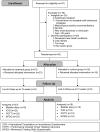Defeating Urinary Incontinence with Exercise Training: Results of a Pilot Study in Frail Older Women
- PMID: 28248418
- PMCID: PMC5478439
- DOI: 10.1111/jgs.14798
Defeating Urinary Incontinence with Exercise Training: Results of a Pilot Study in Frail Older Women
Abstract
Objectives: To determine whether combining behavioral urinary incontinence (UI) treatments with physical activity improves UI in frail older women.
Design: Single-blind, two-arm pilot randomized controlled trial.
Setting: Senior apartments.
Participants: Frail women (mean age 84.9 ± 6.4) without dementia (n = 42).
Intervention: Twelve-week program of customized behavioral UI treatments: 150 minutes of weekly walking and twice weekly strength training classes.
Measurements: UI was measured using 3-day bladder diaries, the International Consultation on Incontinence Questionnaire (ICIQ), and UI global improvement questions. Toileting skills were measured using the Performance Oriented Timed Toileting Instrument (POTTI) and the Minnesota Toileting Skills Questionnaire (MTSQ). Physical function was measured using the Short Physical Performance Battery. UI-related quality of life was measured using the Incontinence Impact Questionnaire and Urogenital Distress Inventory.
Results: The treatment group reported a 50% reduction in daily leaks using bladder diaries, and the control group reported no change (P = .04). Although there were no group differences in total ICIQ scores (P = .66), the treatment group reported significantly greater improvement on the ICIQ item for urine leakage (P = .01). More than 81% of the treatment group and 36% of the control group reported improvement in UI (χ2 = 4.84, P = .01), with mean estimated percentage improvement of 65.3 ± 32.0 versus 34.1 ± 41.3 (P = .03). Although the difference was not statistically significant, treatment group participants improved their toileting skills, whereas those of the control group declined (P = .42 POTTI, P = .11 MTSQ). Balance (P = .33) and gait (P = .24) improved more in the treatment group, whereas chair stands improved more in the control group (P = .14).
Conclusion: UI may be improved in frail older women by combining behavioral strategies for UI with physical activity, but larger trails are needed to determine whether these findings can be replicated and sustained.
Keywords: frail; intervention; older women; randomized controlled trial; urinary incontinence.
© 2017, Copyright the Authors Journal compilation © 2017, The American Geriatrics Society.
Figures
References
-
- Wilson L, Brown JS, Shin GP, et al. Annual direct cost of urinary incontinence. Obstet Gynecol. 2001;98(3):398–406. - PubMed
-
- Holroyd-Leduc JM, Mehta KM, Covinsky KE. Urinary incontinence and its association with death, nursing home admission, and functional decline. J Am Geriatr Soc. 2004;52(5):712–8. - PubMed
-
- Wagg A, Gibson W, Ostaszkiewicz J, et al. Urinary incontinence in frail elderly persons: Report from the 5th International Consultation on Incontinence. Neurourol Urodyn. 2015;34(5):398–406. - PubMed
-
- Stenzelius K, Molander U, Odeberg J, et al. The effect of conservative treatment of urinary incontinence among older and frail older people: A systematic review. Age Ageing. 2015;44(5):736–744. - PubMed
Publication types
MeSH terms
Grants and funding
LinkOut - more resources
Full Text Sources
Other Literature Sources
Medical



